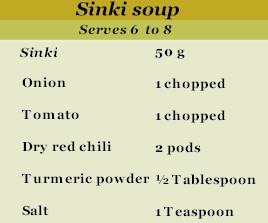Sinki, indigenous fermented radish tap root food, is
traditionally prepared by “pit fermentation”, which is a unique type of
biopreservation of foods by lactic acid fermentation.
|
During sinki production,
2-3 ft pit is dug in dry place and is warmed by burning. The pit is lined
with bamboo sheaths and straw. The radish tap roots are wilted, crushed
and pressed tightly into a pit, covered with dry leaves and weighted down
by heavy planks or stones, the top of the pit are plastered with mud and
left to ferment for a month.

Fig. 5. Flow sheet of traditional method of Sinki preparation.
|
 Soak sinki in
water for 10 min. Heat oil and fry chopped
onions, tomatoes, chilies. Drain
up soaked sinki and fry, add turmeric powder and salt, and put 2 cups of
water. Boil for 10 min, and serve hot with cooked rice. Soak sinki in
water for 10 min. Heat oil and fry chopped
onions, tomatoes, chilies. Drain
up soaked sinki and fry, add turmeric powder and salt, and put 2 cups of
water. Boil for 10 min, and serve hot with cooked rice.

Sinki is sold in
all local periodical markets, called ‘haats’ of these regions by rural women. One
kg of sinki costs about Rs.60/-.

It undergoes a sequence of lactic acid fermentation. Lactobacillus
fermentum initiates the fermentation in sinki production, followed by another homo-fermentative Lb. brevis, and finally succeeded by homo-fermentative Lb.
plantarum, dropping pH of the substrate from 6.7 to 3.3 with ~1.3 %
acidity. After completion of fermentation, fresh sinki is removed and sun-dried, and stored for consumption which can be kept for
several years (Tamang and Sarkar, 1993). |